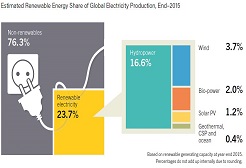Martha Ch. Lux-Steiner
Helmholtz-Zentrum Berlin, Germany
Title: Approaches to reduce material consumptions in photovoltaics
Biography
Biography: Martha Ch. Lux-Steiner
Abstract
Renewable energies are now established as main stream energy resources world-wide. The outlook at the market mainly depends on cost-competitiveness, policy initiatives and regulations, on energy security and environmental issues, as well as on availability to cover the global demands. Among the renewables in the electricity sector today, photovoltaic meet these key indicators exemplarily. Consequently, in the hi-Ren scenario of the International Energy Agency with an annual 6300 TWh electricity production PV provides 16% of global electricity by 2050. To satisfy such demands cost-effectively by established compound semiconductor solar cell base materials, the availability of resources from known economic reserves will be crucial, except that new routes of material savings need to be identified. In order to meet this challenge by cost-effective thin film photovoltaic, various technical approaches have to be considered and will be discussed in this presentation using Cu(In,Ga)(Se,S)2 technology, also named CIS technology, for example: Improving power conversion energy by advanced chemical material engineering and/or electrical device engineering applied to established macroscopic planar, single solar cell device configuration; reducing CIS film thickness without performance losses by means of advanced approaches in optical device engineering such as by implementation of micro- and nanostructures, plasmonics or photonics in single solar cell device configurations; improving power conversion energy by novel tandem photovoltaic concepts, consisting of monolithically stacked solar cells based on two different absorber materials, and furthermore; improving power conversion energy as well as saving material consumption by concentrating photovoltaics, particularly novel designs of microconcentrator photovoltaic concepts. Finally, a smart combination of the different approaches could be most effective. Thus, in addition to long-term stability of device performance, looking for appropriate compatible fabrication technologies will be necessary.

Recent Publications
- Xianzhong Lin et al. (2016) 11.3% efficiency Cu(In,Ga)(S,Se)2 thin film solar cells via drop-on-demand inkjet printing; Energy Environ. Sci. 9, 2037-2043.
- Ringleb F. et al. (2916) Regularly arranged indium islands on glass/molybdenum substrates upon femtosecond laser and physical vapor deposition processing; Applied Physics Letters 108(11):111904.
- Bercegol A. et al. (2016) Point contacts at the copper-indium-gallium-selenide interface — A theoretical outlook; Journal of Applied Physics 119(15):155304.
- Dittrich Th. et al. (2015) Temperature Dependence of the Band Gap of CH3 NH3 PbI3 Stabilized With PMMA: a Modulated Surface Photovoltage Study; Journal of Physical Chemistry C 119(42): 151001161315007.
- Reinhold B. (2015) Monolithically interconnected lamellar Cu(In,Ga)Se 2 micro solar cells under full white light concentration: Monolithically interconnected lamellar Cu(In,Ga)Se2 micro solar cells; Progress in Photovoltaics Research and Applications 23(12).
- Van Lare C., et al. (2015) Light Coupling and Trapping in Ultrathin Cu(In,Ga)Se2 Solar Cells Using Dielectric Scattering Patterns; ACS Nano 9(10).
- Schmid M. et al. (2014) Plasmonic and photonic scattering and near fields of nanoparticles; Nanoscale Research Letters20149:50.
- Schmid M. et al. (2009) Optical modeling of chalcopyrite-based tandems considering realistic layer properties; Applied Physics Letters 94(5):053507 - 053507-3.

